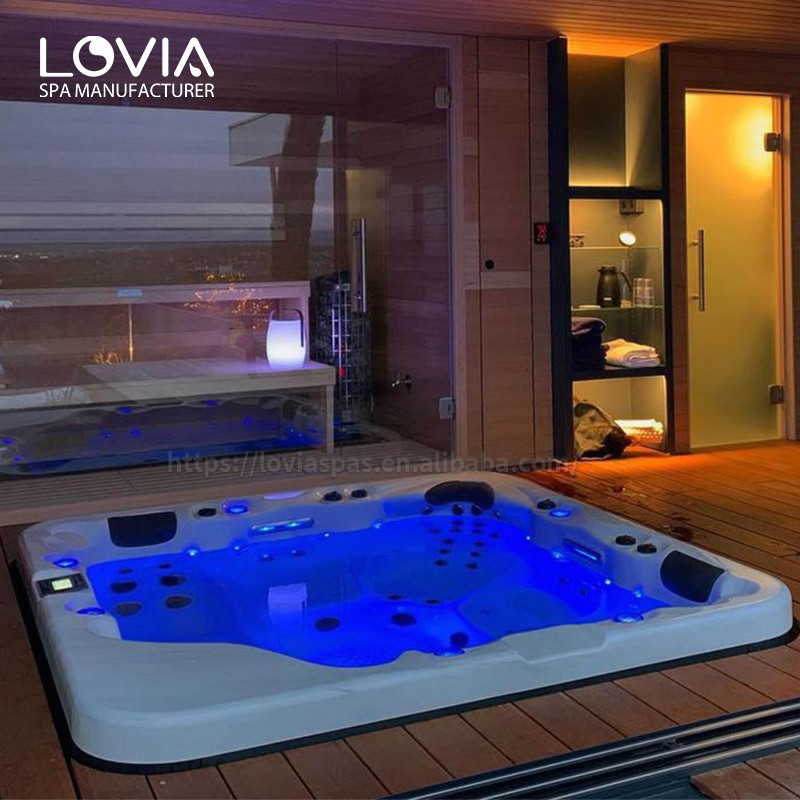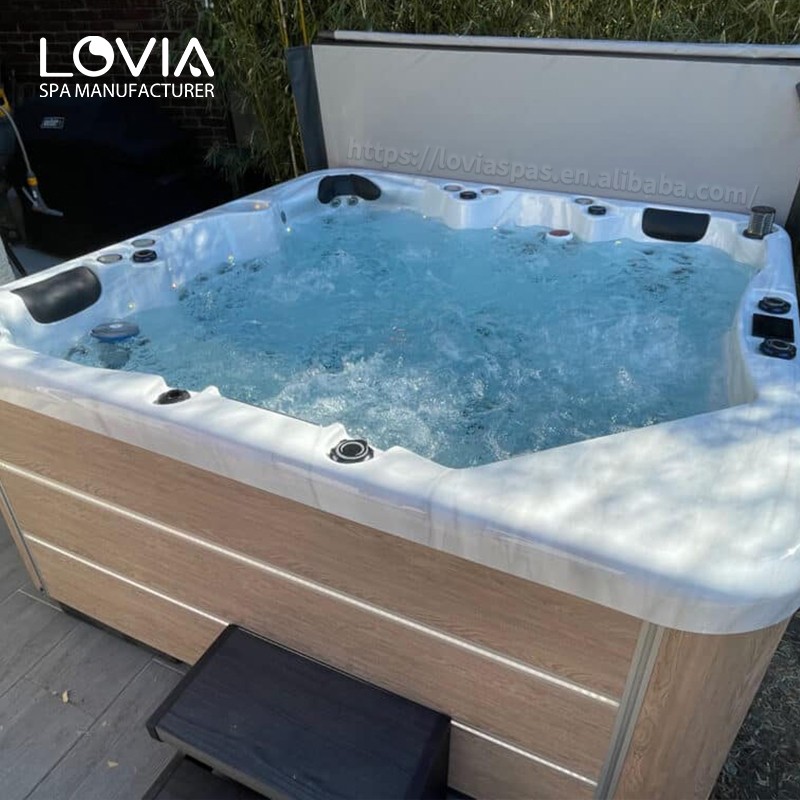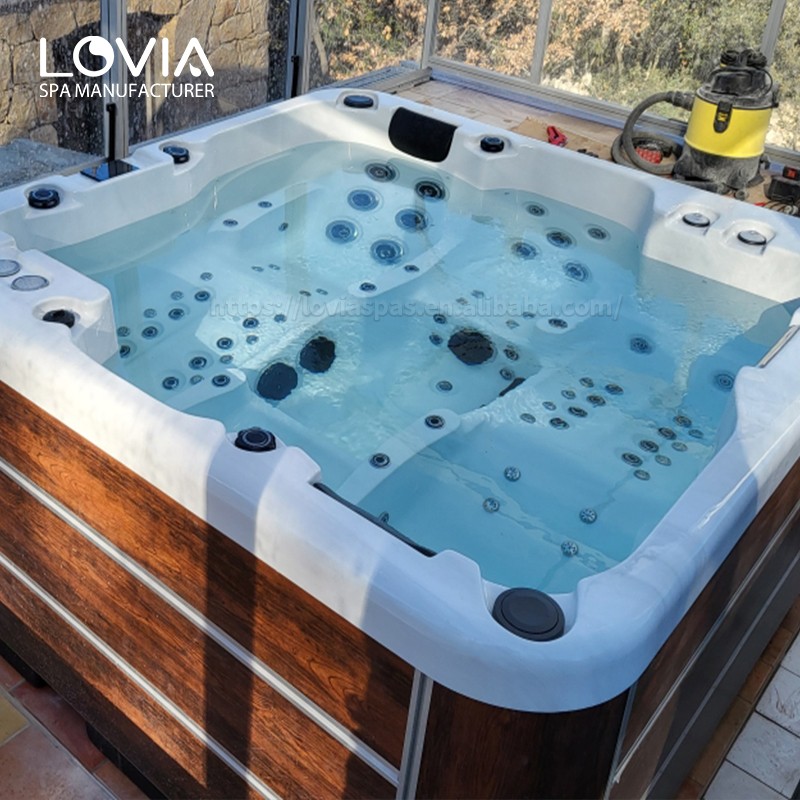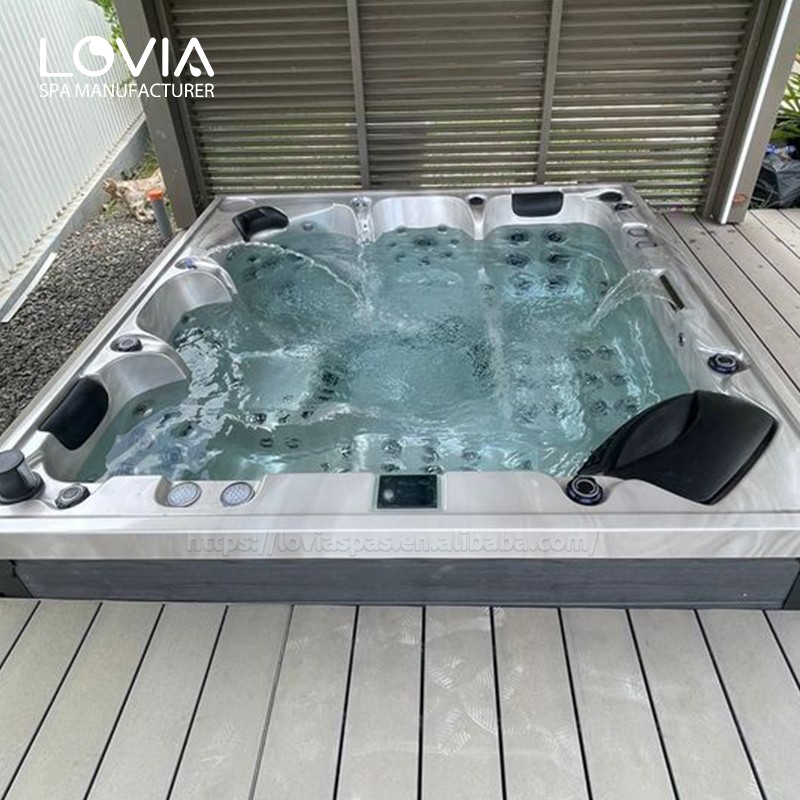
10 Ways to Fix Whirlpool Spa Hot Tub Water Quality
2025-04-07 15:30Homeowners who own a whirlpool spa hot tub know that keeping its water clean and healthy is a top priority to ensure comfortable use. However, over time, various external factors can affect water quality, causing turbidity, odors, and even harmful biological growth. These issues not only affect the user experience of the whirlpool spa hot tub, but can also have an adverse effect on the user's health.
Fortunately, with proper maintenance and regular inspections, most water quality issues can be effectively prevented and resolved. This article will take a closer look at common whirlpool spa hot tub water quality issues and their causes, as well as provide professional solutions and preventive measures to ensure your whirlpool spa hot tub is always clean and safe.

1. Turbid water in spa hot tubs
Turbid water is one of the most common water quality issues in whirlpool spa hot tubs. Typically, clear, transparent water is a sign of healthy water quality, while turbid water indicates that there is something wrong that needs to be addressed immediately. There are many reasons for turbid water, and here are some of the main reasons and their solutions.
● Dirty filter: The function of the whirlpool spa hot tub filter is to capture impurities and particles in the water. If the filter is not cleaned or replaced for a long time, it will lose its filtering effect, resulting in turbid water. The solution is to clean or replace the filter regularly to ensure its normal operation. It is recommended to check the filter once a week, and cleaning or replacement depends on the frequency of use and water quality.
● Excessive accumulation of oil and organic matter: Human oils, skin care products, cosmetics and other organic matter can accumulate in the water, causing turbid water. Specially designed water surface cleaners or enzyme preparations can be used to break down these organic matter. In addition, it is recommended that users shower before entering the whirlpool spa hot tub to reduce the entry of oil and skin care products.
● Improper hygiene: Improper disinfection and maintenance may cause water quality to deteriorate. The growth of bacteria and microorganisms in the whirlpool spa hot tub water may cause the water to become turbid. Make sure to add the right amount of disinfectant, such as chlorine or bromine, and test the disinfectant level in the water regularly to maintain the proper water quality balance.
● Suspended particles or organic matter: Suspended particles or organic matter in the water may cause the water to become turbid when they are not filtered out. At this point, "Shock Treatment" can be used to increase the level of oxidants in the water, thereby breaking down organic matter and impurities and restoring clarity to the water.
● Overuse or old water: Overuse of the whirlpool spa hot tub or water that has not been changed for a long time can also cause turbidity. It is recommended to change the water in the whirlpool spa hot tub every 3 to 4 months depending on the frequency of use, and thoroughly clean the inside of the tub to prevent the accumulation of water quality problems.
2. Spa hot tub water odor
When the water in the whirlpool spa hot tub emits an unpleasant odor, this is usually the result of organic matter accumulation or improper disinfection. Here are the possible reasons and their solutions.
● Excessive accumulation of organic matter: As mentioned earlier, human oils, skin care products, and other organic matter will accumulate in the water, which will cause the whirlpool spa hot tub to stink if it is not treated in time. By using a water surface cleaner and regular shock treatment, the accumulation of these organic matters can be effectively reduced, thereby improving water quality and odor.
● Improper hygiene: Irregular or incorrect disinfection may cause microorganisms in the water to multiply, resulting in bad odors. Make sure to add the right amount of disinfectant regularly and keep the chlorine or bromine level in the water within the recommended range to prevent microbial growth.
● Low pH: If the pH of the water is too low, the acidic environment will accelerate the decomposition of organic matter, causing the water to smell bad. Using a pH adjuster to keep the pH of the water between 7.2 and 7.6 can effectively reduce the generation of odors.

3. Spa hot tub chlorine odor
Chlorine is one of the most commonly used disinfectants in whirlpool spa hot tubs. It can effectively kill bacteria and microorganisms in the water. However, when the level of chloramines (a byproduct of chlorine combining with organic matter) in the water is too high, it will cause a pungent chlorine odor, which not only affects the user experience, but may also be harmful to health.
● Chloramine levels are too high: Chloramines are a byproduct of chlorine combining with organic matter in whirlpool spa hot tub water, and have a strong pungent odor. If the chloramine level is too high, it may be because there is too much accumulation of organic matter in the water. The solution is to perform a shock treatment, which removes the odor by adding a high concentration of oxidants to the water to break down the chloramines into harmless gases.
● Low pH: When the pH of the whirlpool spa hot tub is too low, the disinfecting effect of chlorine will decrease, resulting in the formation of chloramines. Regularly testing and adjusting the pH to between 7.2 and 7.6 can improve the disinfecting effect of chlorine and reduce the formation and odor of chloramines.
4. The spa hot tub has a musty smell
The musty smell in the whirlpool spa hot tub is usually caused by the growth of bacteria or algae in the water. The growth of these microorganisms not only produces odors, but also poses a threat to the health of users.
● Bacterial or algae growth: Bacteria and algae tend to grow easily in warm and humid environments. If the disinfectant level in the water is insufficient or the pH value is not appropriate, it will provide favorable conditions for the growth of these microorganisms. The solution is to perform a thorough shock treatment to kill bacteria and algae in the water. At the same time, clean the surface and filter element of the whirlpool spa hot tub to prevent the regeneration of microorganisms.
● Preventing musty odors: Maintaining proper disinfectant levels and pH levels is key to preventing musty odors. In addition, regularly clean the surface of the whirlpool spa hot tub, especially the edges and corners, to prevent the accumulation of bacteria and algae.
5. A ring of scum around the spa hot tub
If a ring of greasy scum appears on the water surface or edge of the whirlpool spa hot tub, this is usually caused by the accumulation of grease, skin care products, and other organic matter. While these scum may not look aesthetically pleasing, they can also be a breeding ground for bacteria.
● Organic accumulation of oil and dirt: Human oils, skin care products, and other organic matter accumulate in the water and may form greasy scum. Scum formation can be prevented by regularly using a water surface cleaner to remove grease and dirt from the water surface and cleaning the edges of the whirlpool spa hot tub.
● Preventive measures: It is recommended that users shower before entering the whirlpool spa hot tub to reduce the entry of grease and skin care products. Regular water changes and cleaning of the tub can also help prevent the accumulation of scum.

6. Algae Growth
Algae growth not only causes the water to turn green, but may also make the water slippery, affecting the overall appearance and user experience of the whirlpool spa hot tub. Algae growth is usually caused by insufficient disinfectant levels or high pH values.
● High pH: Algae grows easily in an environment with a high pH value. If the pH value of the whirlpool spa hot tub is detected to be too high, using a pH reducer to adjust it to between 7.2 and 7.6 can effectively inhibit the growth of algae.
● Low disinfectant level: Low concentrations of disinfectants may not be enough to kill algae in the water. Regularly testing and maintaining the chlorine or bromine level in the whirlpool spa hot tub water within the recommended range is an effective measure to prevent algae growth.
● Cleaning and prevention: Once algae growth is found, immediately perform shock treatment and clean the surface and filter element of the whirlpool spa hot tub. In order to prevent algae regeneration, it is recommended to regularly check and maintain water quality.
7. Eye irritation
Eye irritation is a common problem when using a whirlpool spa hot tub and is usually caused by low pH or improper disinfectant levels in the water. The pH of the eye is usually between 7.2 and 7.4, and if the pH in the whirlpool spa hot tub deviates from this range, it may cause eye discomfort.
● Low pH: If the pH of the whirlpool spa hot tub water is too low, the water may become acidic, which can irritate the eyes. Eye irritation can be effectively reduced by regularly testing the pH and using a pH raiser to adjust it to the proper range.
● Low disinfectant level: Inadequate disinfectant concentration may not effectively kill bacteria and microorganisms in the whirlpool spa hot tub water, causing eye irritation. Regularly testing and maintaining chlorine or bromine levels in the water within the recommended range is an important measure to prevent eye irritation.
8. Skin irritation or rash
Skin irritation or rash is usually caused by unsanitary water quality or excessive free chlorine levels in the water. These problems not only affect the user's comfort, but may also lead to more serious skin problems.
● Unsanitary water: If the water quality is poor, the growth of bacteria and other harmful microorganisms may cause skin irritation or rash. Regular shock treatment and disinfection are key to keeping the water clean. In addition, regular water changes and cleaning of the interior surfaces of the whirlpool spa hot tub should be carried out.
● Free chlorine levels above 5 ppm: When the free chlorine level in the water exceeds 5 ppm, it may cause skin irritation. At this time, the whirlpool spa hot tub should be suspended and the water quality should be restored to balance by reducing the chlorine concentration. The free chlorine level can be reduced by diluting the water or using a chlorine neutralizer.

9. Spa hot tub stains
Stains in whirlpool spa hot tub water are usually caused by low total alkalinity and/or pH, or high levels of metals such as iron and copper in the water source. Stains not only affect the beauty of the water quality, but may also cause corrosion and damage to the equipment.
● Low total alkalinity and/or pH: Low total alkalinity and pH can cause the water to become acidic, which can corrode metal parts and cause metal ions such as iron and copper to dissolve in the water, forming stains. These problems can be prevented by regularly testing and adjusting alkalinity and pH.
● High iron or copper content in the water source: Some areas may have high iron or copper content in the water source, which reacts with oxygen in the water to form stains. Using the appropriate metal remover can effectively reduce the accumulation of these metals in the water, thereby preventing the formation of stains.
10. Spa hot tub scale
Scale formation is caused by excessive calcium content in the water, combined with high total alkalinity and pH. Scale not only affects the appearance of the whirlpool spa hot tub, but can also cause damage to the equipment, such as clogged nozzles and reduced heater efficiency.
● High calcium content in the water: Excessive calcium ion content in the water can cause scale formation. If the whirlpool spa hot tub calcium hardness is detected to be too high, a water softener or calcium remover can be used to reduce the calcium content in the water to prevent scale formation.
● High total alkalinity and pH: High alkalinity and pH will accelerate the precipitation of calcium, thereby forming scale. Regularly testing and adjusting the total alkalinity and pH of the water can effectively prevent the formation and accumulation of scale.
Looking for a trusted supplier of hot tubs and swim spas? Lovia Spa, a global manufacturer and wholesaler, provides premium outdoor spa solutions. Our factory, covering 45,000 square meters, is equipped with cutting-edge technology and highly skilled professionals. With CE, ETL, SAA, ROHS, and ISO9001 certifications, we guarantee top-tier quality at competitive prices. Contact us for discounts, bulk purchasing, and customized orders today!
